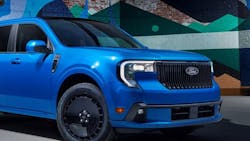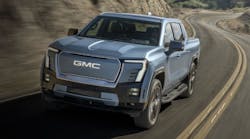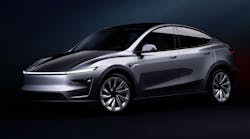Stellantis Chairman: Real Tariff Opportunity Is in Closing ‘Loophole’ for Cars Without U.S. Content
Editor’s note: This article originally ran Feb. 6 focused on comments by Ford’s Jim Farley. It is updated here to include similar commentary from another of the world’s largest auto manufacturers.
The executive chairman of Stellantis NV, the globe’s No. 3 car manufacturer, said Feb. 26 that the Trump administration’s trade policies could most effectively help the domestic automotive industry by focusing on imported cars that contain no parts made in the United States.
Speaking to analysts and investors after Stellantis—the parent of Chrysler, Jeep, Fiat and a host of other brands around the world—reported fourth-quarter results, John Elkann said his team wants the White House to maintain the tariff-free approach to products made in Canada and Mexico that was enshrined in the United States-Mexico-Canada Agreement that became effective in mid-2020.
“We strongly believe that the real opportunity is really to try and close the loophole for 4 million cars that are sold in America that don’t have any U.S. content,” Elkann said. “We’re very aligned with the [Detroit Three] in those conversations and making sure that what was negotiated by the first Trump administration to create USMCA is actually respected and valued and eventually improved.”
Ford Motor Co. would be in “good shape” if tariffs imposed on Canada and Mexico by President Donald Trump were to last only a few weeks, President and CEO Jim Farley said Feb. 5. But Farley also called for a far more comprehensive approach to tariffs as it relates to the automotive sector.
“What doesn’t make sense to me is why are we having this conversation while Hyundai Kia is importing 600,000 units into the U.S. with no incremental tariff and why is Toyota able to import half a million vehicles in the U.S. with no incremental tariffs,” Farley said on a conference call discussing Ford’s fourth-quarter results. “We can’t just cherry-pick one place or the other because this is a bonanza for our import competitors.”
Speaking to analysts on the afternoon of Feb. 5, Farley pointed out that Ford makes more than 80% of its vehicles, all of its transmissions and more than half of its engines in the United States. The company’s domestic footprint, he added, is running “flat out already” and a prolonged trade war would wipe out billions of profits at auto makers and call for “some major strategy shifts” to Ford’s production footprint.
In the short term, Ford’s leader said the company wouldn’t have to overhaul its operations should the Trump administration impose tariffs on Canada and Mexico.
“We can make sure nothing crosses the border for a couple of weeks,” he said. “We have a good stock situation in our dealers right now.”
Farley’s tariffs comments—he also said the Ford team believes Trump and congressional leaders don’t want to weaken the U.S. auto sector—came after Ford reported a fourth-quarter net profit of about $1.8 billion on sales of $48.2 billion. (A year prior, those numbers were a loss of $500 million and $46.0 billion, respectively.) The company delivered nearly 1.19 million vehicles during the quarter, an increase of 3% from late 2023.
Looking to 2025, Farley and his lieutenants expect Ford will produce adjusted earnings before interest and taxes of $7 billion to $8.5 billion, down from $10.2 billion last year. They expect to generate $1 billion of cost cuts from operations and put between $8 billion and $9 billion toward capital projects—in line with the $8.7 billion and $8.2 billion spent in 2024 and 2023, respectively.
The company’s Model e electric-vehicle division lost $5.1 billion before interest and taxes last year—sales fell 9% but revenues slid 35% to $3.9 billion due to broad pricing pressures—and executives are calling for 2025’s losses to also be in that range. Still, Farley said he is confident that his focus to have Ford’s next generation of EVs—they’re expected to start hitting the market in the second half of 2027—be mostly small and mid-sized vehicles and “not me-too products” will pay off.
“I would say our bet a couple of years ago to build that platform […] winds up being a good move,” he said.
Investors aren’t yet ready to agree, it appears. On the afternoon of Feb. 6, shares of Ford (Ticker: F) were changing hands around $9.40, down more than 6% from their previous close. They’re down a few percentage points over the past six months as well, leaving Ford with a market capitalization of about $37.2 billion.
About the Author
Geert De Lombaerde
Senior Editor
A native of Belgium, Geert De Lombaerde has been in business journalism since the mid-1990s and writes about public companies, markets and economic trends for Endeavor Business Media publications, focusing on IndustryWeek, FleetOwner, Oil & Gas Journal, T&D World and Healthcare Innovation. He also curates the twice-monthly Market Moves Strategy newsletter that showcases Endeavor stories on strategy, leadership and investment and contributes to other Market Moves newsletters.
With a degree in journalism from the University of Missouri, he began his reporting career at the Business Courier in Cincinnati in 1997, initially covering retail and the courts before shifting to banking, insurance and investing. He later was managing editor and editor of the Nashville Business Journal before being named editor of the Nashville Post in early 2008. He led a team that helped grow the Post's online traffic more than fivefold before joining Endeavor in September 2021.


